Understanding How Work Horses Are Bred

Ever thought about how work horses are bred? They power our farms and industries. Let’s explore how they’re bred, focusing on traits that make them strong. Knowing this is key for creating capable horses and keeping their lineage pure.
We’ll look at natural breeding and the role of nutrition. These methods are vital in the United States. They help breed work horses that are reliable and efficient.
Key Takeaways
- Work horses are bred for specific traits to enhance their agricultural effectiveness.
- The breeding process includes both natural methods and innovations such as artificial insemination.
- Nutritional needs during breeding are critical for the health of mares and their foals.
- Genetic diversity is essential to prevent health issues within horse populations.
- Understanding historical context aids in appreciating the evolution of work horse breeds.
Introduction to Work Horses
Work horses have played a key role in our history and in farming. They are special horses bred for hard work in tasks like farming, logging, and moving goods. Their strength, endurance, and smart nature make them very important.
Definition of Work Horses
Work horses are more than just strong animals. They are bred for their ability to do tough jobs. Their connection with humans helps us work better in farming and industry.
Importance of Work Horses in Agriculture
In the 19th century, over 27,000 draft horses helped with farming and industry. Their power and stamina helped farmers work more efficiently. Even today, some groups like the Amish and Mennonites still use them for farming.
Overview of Breeding Practices
Breeding work horses has changed over time. Breeders focus on traits like strength, endurance, and calmness. This has made these horses popular again, not just for work but also in competitions and fun activities.
Historical Context of Work Horse Breeding
The history of breeding work horses is filled with change. It shows how these animals adapted to human needs over time. We see how different breeds came to be, shaped by their environment, work, and technology.
Evolution of Work Horse Breeds
Many factors shaped the evolution of work horse breeds. In the late 1800s to early 1900s, thousands of draft horses came to the U.S. from Europe. By 1900, over 27,000 of these horses were registered in America. Most public works and farms relied on them for labor.
Key Breeds and Their Origins
The Percheron is a standout among breeds. By 1915, it was the most common draft horse in America. The Clydesdale, known for its beauty and strength, also became famous. The American Cream Draft was developed in the U.S., showing the country’s ability to create breeds for its needs.

In the 2000s, draft horses saw a comeback in popularity. Events and exhibitions celebrated these animals. Breeders work hard to keep these breeds alive for future generations. This shows the lasting importance of work horse breeds in our farming history.
Selecting Breeding Stock
In our quest to excel in selecting breeding stock for work horses, we must identify key criteria. These criteria ensure we produce strong, capable animals. Understanding work horse genetics guides us in making informed breeding decisions.
Criteria for Choosing Work Horses
When evaluating potential breeding stock, we focus on several key areas:
- Conformation: A horse’s physical structure affects its strength, agility, and ability to perform tasks.
- Temperament: Horses with a calm and trainable disposition are often best for work duties.
- Performance History: Looking at a horse’s past performance helps us understand its work ability.
- Genetics: Studying the bloodlines of prospective horses is crucial. We seek horses from proven lines with desirable traits.
Importance of Genetic Diversity
Keeping genetic diversity is key for the long-term health of our work horses. A diverse breeding program helps us:
- Reduce the risks of inbreeding, which can cause health problems and reduced vigor in offspring.
- Introduce unrelated genetics, strengthening the breed and improving disease resistance.
- Boost overall population vitality, promoting adaptability in different environments.

Breeding Techniques
Breeding work horses involves using effective methods to produce strong, healthy foals. We look at work horse breeding techniques, focusing on natural methods and artificial insemination. Each has its own benefits and considerations.
Natural Breeding Methods
Natural breeding includes pasture mating and hand mating, key in traditional horse breeding. In pasture mating, stallions and mares freely interact in a designated area. This method uses their natural instincts for successful breeding.
Hand mating is more controlled. Breeders closely watch the mare’s cycle and breed at the best times. This increases the chance of successful conception. The natural behaviors of the horses can also strengthen their bond and the potential of their offspring.
Artificial Insemination
Artificial insemination is becoming more popular for its precision and flexibility. It allows breeders to use superior genetics without the stallion’s physical presence. They can ship semen over long distances, improving the genetic pool.
Breed registry rules for artificial insemination focus on genetic quality and health. The success rate is around 65% to 70%. However, some operations report higher pregnancy rates.
Timing insemination with the mare’s ovulation cycle is key. This method also provides insights into reproductive health. Ultrasound exams can monitor the mare during breeding. Working with veterinarians is essential for choosing the best breeding methods and timing.
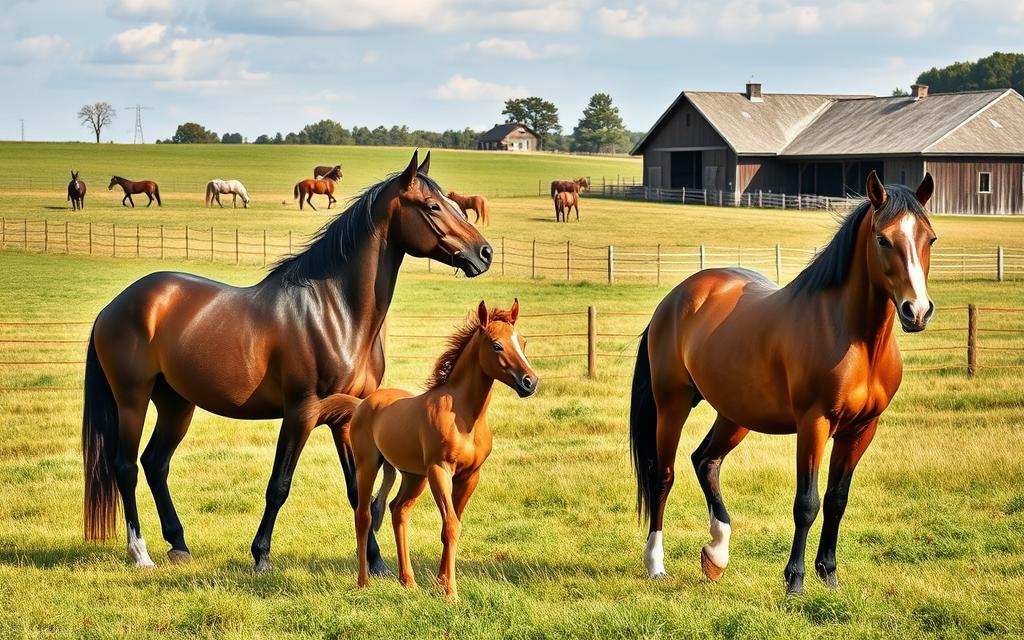
Nutrition and Health in Breeding
Nutrition and health are key in breeding work horses, especially for pregnant mares. Good nutrition is crucial for a healthy pregnancy and foal growth. Mares need proteins, vitamins, and minerals to support them during this important time.
Essential Nutrients for Pregnant Mares
It’s vital to give pregnant mares a diet full of important nutrients:
- Proteins: They are key for the baby’s growth.
- Vitamins: Vitamins A, E, and D boost the immune system and bone health.
- Minerals: Calcium and phosphorus are needed for strong bones.
- Omega-3 fatty acids: They help with reproductive health and fetal growth.
Thinking about these nutrients helps the mare and her foal stay healthy. This sets the stage for a successful breeding.
Health Management Practices
Good nutrition is just part of the story. Health management for work horses is also crucial. Regular vet visits and shots keep diseases away. Deworming routines also keep the digestive system healthy.
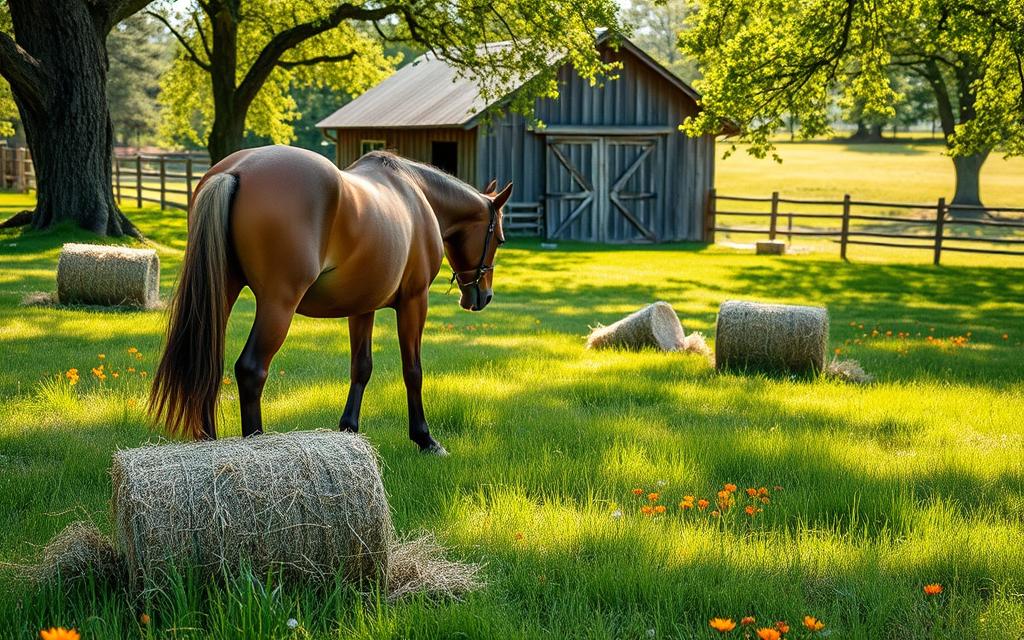
The Role of Horse Breeders
As horse breeders, we handle many important tasks. We pick the best animals for breeding and take care of their health and food. This job needs us to know a lot and be quick to adapt to new challenges.
Responsibilities of a Work Horse Breeder
Our main duties include:
- Selecting breeding stock that fits the traits we want in work horses.
- Keeping horses healthy with vet visits, food plans, and exercise.
- Keeping detailed records of lineage, breeding results, and health.
- Helping with foaling and caring for newborns, which is very important.
- Running our business well, including managing money, to keep our operations going.
Building Knowledge and Expertise
Learning more about work horse breeding is key to our success. We need to keep learning and practicing to stay up-to-date. Important areas to focus on include:
- Understanding genetics to choose the best breeding pairs.
- Learning about horse behavior and nutrition, which affects breeding results.
- Getting good at scientific methods like artificial insemination to help with breeding.
- Going to workshops and seminars to share and learn from others.
In Pennsylvania, our dedication to learning and improving helps the horse breeding industry grow.
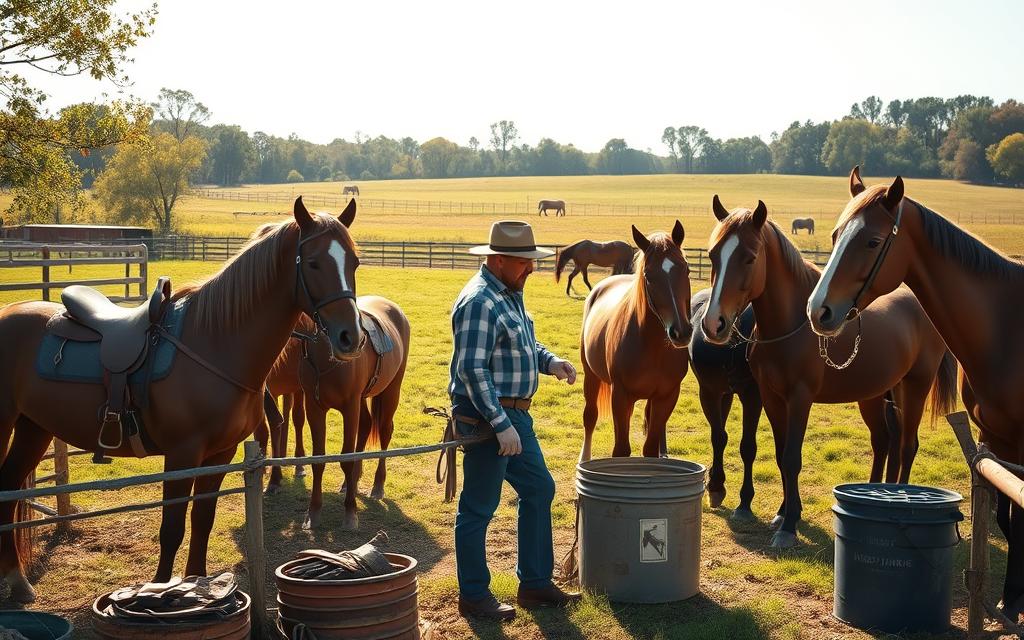
Training Work Horses
Training work horses is key to their success. Early training helps them learn important skills. This includes commands, social skills, and basic tasks. Starting early gives them the best chance to excel in their roles.
Early Training Practices
Early training is vital for work horses. It prepares them for a lifetime of service. Key practices include:
- Socialization: Young horses need to meet different environments and animals to avoid future problems.
- Basic Commands: Teaching simple commands like “whoa,” “walk on,” and “back” helps horse and handler communicate.
- Desensitization: Getting horses used to common noises and movements keeps them calm at work.
- Ground Work: Exercises on the ground build trust and a strong bond before riding starts.
Integration of Training and Breeding
Training principles should guide breeding decisions. This way, breeders can choose horses that are easy to train. These horses will be strong and mentally ready for their duties. Traits that make training easier can greatly improve performance in work settings.
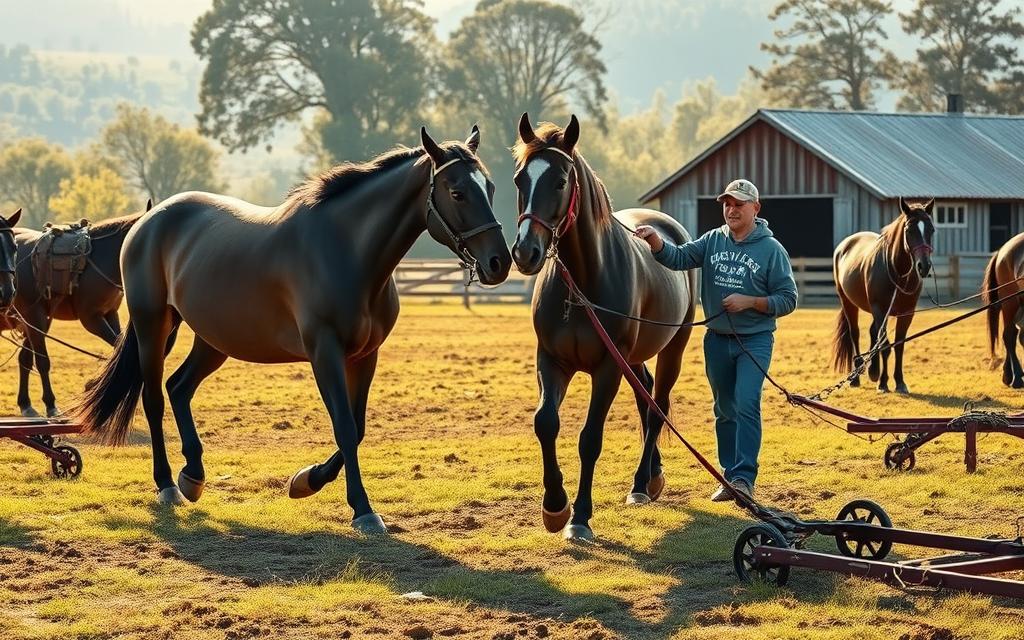
Evaluating Work Horse Performance
We look at many metrics to understand work horses better. We check their strengths and how well they fit certain tasks. Keeping accurate records is key for making smart breeding choices and better horse care.
Metrics for Assessing Work Horses
When we evaluate work horses, we focus on several key points. These include:
- Balance: This is crucial for good movement. It means the horse’s body is well-structured, with muscles evenly spread, for top performance.
- Structural Correctness: This affects how the horse moves. It’s about the bones in the legs being in line.
- Muscling: We look at the amount, quality, and where the muscles are.
- Breed and Sex Character: This checks if the horse meets breed standards. It’s important for events like halter classes.
- Depth of Heart Girth: A deeper heart girth means more room for vital organs. This boosts vitality and performance.
Importance of Performance Records
Performance records are very important. They help us track a horse’s growth and find areas to improve. These records are great for:
- Making smart breeding choices, focusing on the right traits for future generations.
- Seeing how a horse improves over time. This shows their strengths and challenges in different tasks.
- Setting a standard for training. This lets us adjust training based on past performance.
Challenges in Breeding Work Horses
Exploring the challenges in breeding work horses reveals many issues affecting their health and success. We must tackle health problems and market changes with care and attention.
Common Health Issues
Work horses face several common health issues that can harm their performance and lifespan. Some common problems include:
- Conformation defects, which can lead to joint problems and reduced mobility.
- Metabolic disorders such as Equine Metabolic Syndrome, affecting their weight management and overall health.
- Soundness variability, where some horses remain fit well into their older years, while others may experience injuries early on.
These health issues complicate breeding practices and demand ongoing health management by breeders. It’s crucial for the horses’ welfare.
Environmental and Market Considerations
The breeding landscape has become more complex due to environmental and market factors. We must consider:
- Land availability, limiting space for proper breeding facilities.
- Feed costs, which have risen and can affect the overall sustainability of breeding operations.
- The fluctuating demand for work horses in agriculture, making it difficult to predict future market conditions.
Professional breeders with knowledge and resources are key to overcoming these challenges. Their reputation greatly influences sales, shaping market dynamics. Understanding these challenges can lead to better breeding practices and outcomes for both horses and breeders.
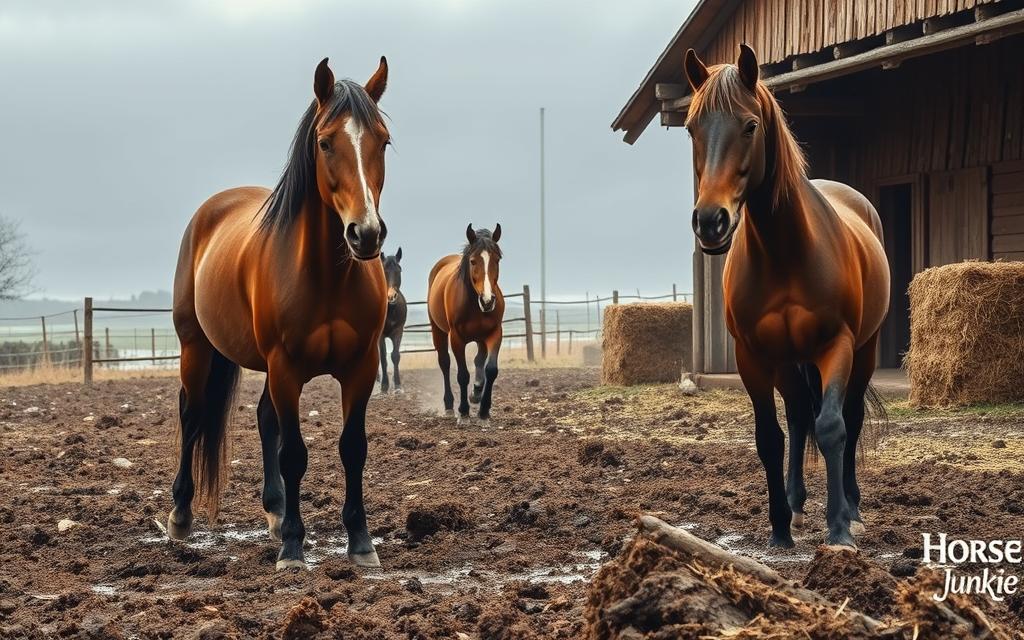
The Future of Work Horse Breeding
Looking ahead, technology and new methods will change work horse breeding a lot. Cloning and precision breeding are bringing new chances to improve horse quality and diversity.
Innovations in Breeding Practices
Cloning has changed breeding a lot since 2013. Kheiron has cloned about 200 horses, but only 20 are in polo now. This makes it easier to keep and grow the genetic pool.
Cloning lets us bring back the breeding ability in males and copy good traits from top horses. Precision breeding is another big change. It aims to make breeding more efficient by focusing on specific traits.
This method cuts down on waste. Traditional breeding often needs many births to get a few top horses. Precision breeding does the same job with fewer births, saving money and time.
Sustainability in Work Horse Breeding
Being green is key for the future of work horse breeding. We must keep breeding healthy and safe for the planet. Climate change is making it harder to breed horses, so we need to adapt.
Our goal is to use new breeding methods that are also good for the environment. This way, we can keep our horse breeds healthy and strong. The future of work horse breeding depends on using new ideas and being responsible.
Conclusion: The Value of Our Work Horses
Work horses have been crucial throughout history. Their breeding has led to the development of strong breeds like the Belgian, Clydesdale, and Percheron. These horses have been key in agriculture and transportation.
This history shows their endurance and versatility. It also reminds us of our duty to keep their qualities alive.
Recap of Breeding Importance
The horse population in the U.S. grew from 4.3 million in 1840 to 27.5 million by 1910. This growth shows the success of breeding efforts. The size of draft horses doubled between 1860 and 1880, showing how breeding has improved their abilities.
Today, we need to keep breeding work horses important. We should mix old traditions with new ways to care for them.
Final Thoughts on Work Horse Breeding
There are challenges ahead, like overbreeding and modern livestock management. But we must keep working on breeding work horses. They are gentle, hardworking, and good for the environment.
By valuing our work horses and breeding them responsibly, we can make sure they last for many years.
FAQ
How are work horses bred for performance?
What are some key breeds of work horses?
Why is genetic diversity important in work horse breeding?
What are the advantages of artificial insemination in work horse breeding?
What kind of nutrition is essential for pregnant mares?
What responsibilities do work horse breeders have?
How can training practices impact work horse breeding?
What metrics are used to evaluate the performance of work horses?
What common health issues might arise in work horses?
What innovations are shaping the future of work horse breeding?
Source Links
- Rural Heritage Work Horses in a Market Garden Part 2 Draft Horse Breeds
- How Many Horse Breeds Are There?
- Horse Breeds: An In-Depth Guide – EverythingEQ
- How Work Horses Have Helped Humans Over The Ages
- Draft Horses: Go Big
- Draft Horses
- JWAL–Library: Draft Horse Resources: Historical Context
- Draft horse
- History of the Draft Horse: The Muscle-Men of the Horse World
- Horse breeding
- Horse Breeding Basics
- Developing a Horse Breeding Program
- 8 Steps of Breeding Mare: How Do You Breed Horses?
- A Summary of the Methods of Breeding Horses – Iron Horse Equine
- Breeding basics
- Horse Husbandry–Nutrition, Management and Welfare
- Select Breeders Services – Nutritional Considerations for the Breeding Stallion
- Feeding Breeding Stallions
- Breeding Horses
- Pennsylvania Horse Racing — Breeding Basics
- Draft Horses
- Evaluating Horse Conformation
- Evaluating Common Equine Performance Classes
- Breeding Pro’s and Con’s
- Bred to Death – Animal Aid
- How Thoroughbred Horses Work
- Is "Precision Breeding" the Future of Horse Sport?
- The World of Sport Horse Breeding: A Journey Through Tradition and Innovation
- The future of the horse industry. Bulletin no. 18 February 1922
- Book Summary: “Horses at Work: Horses in Industrial America” by Ann Norton Greene
- Draft Horses: Gentle Giants of the Equine World Draft horses, also known as heavy horses or work horses, are large, powerful equines bred for their



